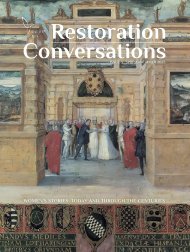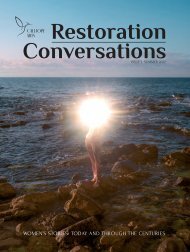Autumn/Winter 2022
Restoration Conversations is a digital magazine spotlighting the achievements of women in history and today. We produce two issues a year: Spring/Summer and Fall/Winter
Restoration Conversations is a digital magazine spotlighting the achievements of women in history and today. We produce two issues a year: Spring/Summer and Fall/Winter
Create successful ePaper yourself
Turn your PDF publications into a flip-book with our unique Google optimized e-Paper software.
“I am becoming<br />
somebody”<br />
Paula Modersohn-Becker at the Royal Academy of Art<br />
By Margie MacKinnon<br />
Four pioneering female artists of the avantgarde<br />
movement in Germany are the focus of a<br />
new exhibition at London’s Royal Academy of Art.<br />
Opening in November <strong>2022</strong>, ‘Making Modernism’<br />
features the work of Gabriele Münter, Käthe<br />
Kollwitz, Paula Modersohn-Becker and Marianne<br />
Werefkin. All four were working in Germany in<br />
the early 1900s, exploring themes of identity,<br />
representation and belonging. The Modernist<br />
movement in art began at the end of the<br />
nineteenth century. It was a rejection of traditional<br />
approaches to art, notably the realistic depiction of<br />
subjects, in favour of experimentation with form<br />
and colour, and a leaning towards abstraction.<br />
Expressionism, which was an early manifestation<br />
of Modernism, originated in Northern Europe and<br />
was particularly popular in Germany.<br />
With the exception of Kollwitz, who abandoned<br />
painting altogether after 1890, in favour of etching<br />
and, later, sculpture and woodcuts, these early<br />
Expressionist painters created works of startling<br />
simplicity and intense colours, with forms defined<br />
by dark outlines. Seeking to convey emotions and<br />
the responses that events arouse within a person,<br />
Expressionism is characterised by the use of<br />
vivid colours, and forms that have been reduced<br />
to their purest essence. Münter described her<br />
pictures as “moments of life … instantaneous<br />
visual experiences, generally noted very rapidly<br />
and spontaneously.” Werefkin was influenced by<br />
Van Gogh, Gauguin and Edvard Munch, as well as<br />
the ideas of the Nabis painters (such as Edouard<br />
Vuillard) whose works emphasised the flatness of<br />
the painting surface through the use of simplified<br />
areas of colour.<br />
Within this group of accomplished artists,<br />
Paula Modersohn-Becker stands out, partly<br />
because of the subject matter of her works and<br />
her unapologetic unidealised portraits of girls<br />
and women, and partly because she managed to<br />
develop her artistic vision and create a lasting<br />
legacy, despite dying at the age of only 31.<br />
Left: Paula Modersohn-Becker, Mother with Child on<br />
her Arm, Nude II, autumn 1906. Oil on canvas,<br />
80 x 59 cm. Museum Ostwall im Dortmunder U.<br />
(Photo: Jürgen Spiler, Dortmund).<br />
<strong>Autumn</strong> / <strong>Winter</strong> <strong>2022</strong> • Restoration Conversations 79





